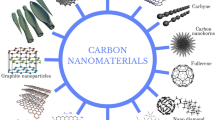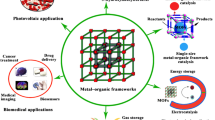Abstract
A series of three-dimensional magnetic covalent organic frameworks were designed and synthesized via monomer selection, coating thickness optimization, and composite strategy transformation. Their structure properties including morphology, functional group, surface area, and pore size were characterized. The relationship between the structural properties and analytical performance was systematically investigated by density functional theory calculation and batch extraction experiments for polycyclic aromatic hydrocarbons. It is proven that the extractant modified by monomer 1,4-phthalaldehyde provides a high affinity for high molecule weight polycyclic aromatic hydrocarbons and the right balance between extraction and elution efficiency. The relationship between coating thickness and mass transfer rate of polycyclic aromatic hydrocarbons was studied by accurate tuning of coating layers via layer-by-layer method. A mathematical model was derived and employed to determine that two coating layers were sufficient to provide the highest extraction efficiency with the shortest equilibrium time. The extractants synthesized by two different composite strategies (layer-by-layer and one-step) show opposite selectivity for polycyclic aromatic hydrocarbons. After optimization of the extraction conditions, dispersed solid-phase extraction coupled with gas chromatography-mass spectrometry method was developed providing a wide linear range (5–500 ng L−1), good linearity (R2 > 0.9923), high precision in intra-day (RSD% < 8.2%) and inter-day (RSD% < 12.3%) detection, and low detection limits (1.5–15.1 ng L−1). The method was applied to the simultaneous determination of 16 polycyclic aromatic hydrocarbons with acceptable recoveries, which were 87–109% for groundwater, 83–116% for East Lake water, and 82–116% for Yangtze River water samples.




Similar content being viewed by others
References
Tahmasebi E, Yamini Y (2014) Polythiophene-coated Fe3O4 nanoparticles as a selective adsorbent for magnetic solid-phase extraction of silver(I), gold (III), copper (II) and palladium (II). Microchim Acta 181:543–551
Ghaemmaghami M, Yamini Y, Mousavi Z (2020) Accordion-like Ti3C2Tx MXene nanosheets as a high-performance solid phase microextraction adsorbent for determination of polycyclic aromatic hydrocarbons using GC-MS. Microchim Acta 187:151–158
Asgharinezhad AA, Ebrahimzadeh H (2016) Poly(2-aminobenzothiazole)-coated graphene oxide/magnetite nanoparticles composite as an efficient sorbent for determination of non-steroidal anti-inflammatory drugs in urine sample. J Chromatogr A 1435:18–29
Rezvani M, Asgharinezhad AA, Ebrahimzadeh H, Shekari N (2014) A polyaniline-magnetite nanocomposite as an anion exchange sorbent for solid-phase extraction of chromium (VI) ions. Microchim Acta 181:1887–1895
Sohaniyan M, Manoochehri M, Daghighi Asli M (2019) Liquid chromatographic determination of trace levels of nitrophenols in water samples after dispersive magnetic solid phase extraction. J Sep Sci 42:3528–3534
Lin X, Wang X, Wang J, Yuan Y, di S, Wang Z, Xu H, Zhao H, Qi P, Ding W (2020) Facile synthesis of a core-shell structured magnetic covalent organic framework for enrichment of organophosphorus pesticides in fruits. Anal Chim Acta 1101:65–73
Asgharinezhad AA, Ebrahimzadeh H (2016) A simple and fast method based on mixed hemimicelles coated magnetite nanoparticles for simultaneous extraction of acidic and basic pollutants. Anal Bioanal Chem 408:473–486
Akbar Asgharinezhad A, Ebrahimzadeh H (2015) Oxide graphene Coextraction of acidic, basic and amphiprotic pollutants using multiwalled carbon nanotubes/magnetite nanoparticles@polypyrrole composite. J Chromatogr A 1412:1–11
Wei T-C, Hillhouse HW (2007) Mass transport and electrode accessibility through periodic self-assembled nanoporous silica thin films. Langmuir 23:5689–5699
Gharibshahi R, Jafari A, Haghtalab A, Karambeigi MS (2015) Application of CFD to evaluate the pore morphology effect on nanofluid flooding for enhanced oil recovery. RSC Adv 5:28938–28949
Diercks CS, Yaghi OM (2017) The atom, the molecule, and the covalent organic framework. Science 355:924
El-Kaderi HM, Hunt JR, Mendoza-Cortés JL et al (2007) Designed synthesis of 3D covalent organic frameworks. Science 316:268–272
Tang Y, Liu H, Gao J, Liu X, Gao X, Lu X, Fang G, Wang J, Li J (2018) Upconversion particle@Fe3O4@molecularly imprinted polymer with controllable shell thickness as high-performance fluorescent probe for sensing quinolones. Talanta 181:95–103
Gao C, Lin G, Lei Z, Zheng Q, Lin J, Lin Z (2017) Facile synthesis of core-shell structured magnetic covalent organic framework composite nanospheres for selective enrichment of peptides with simultaneous exclusion of proteins. J Mater Chem B 5:7496–7503
Xiao FX, Pagliaro M, Xu YJ, Liu B (2016) Layer-by-layer assembly of versatile nanoarchitectures with diverse dimensionality: a new perspective for rational construction of multilayer assemblies. Chem Soc Rev 45:3088–3121
Mackay D, Shiu WY, Lee SC, Ma KC (2006) Handbook of physical–chemical properties and environmental fate for organic chemicals. Science,Technology, Engineering, I-IV. CRC, Boca Raton
Boström CE, Gerde P, Hanberg A et al (2002) Cancer risk assessment, indicators, and guidelines for polycyclic aromatic hydrocarbons in the ambient air. Environ Health Perspect 110:451–488
Yu J, Zhu S, Pang L, Chen P, Zhu GT (2018) Porphyrin-based magnetic nanocomposites for efficient extraction of polycyclic aromatic hydrocarbons from water samples. J Chromatogr A 1540:1–10
Li Y, Yang CX, Yan XP (2017) Controllable preparation of core-shell magnetic covalent-organic framework nanospheres for efficient adsorption and removal of bisphenols in aqueous solution. Chem Commun 53:2511–2514
Ma T, Li J, Niu J, Zhang L, Etman AS, Lin C, Shi D, Chen P, Li LH, du X, Sun J, Wang W (2018) Observation of interpenetration isomerism in covalent organic frameworks. J Am Chem Soc 140:6763–6766
Seminario JM, Politzer P (1995) Modern density functional theory : a tool for chemistry, Elsevier, Amsterdam
Liu X, Su Z, Ji W, Chen S, Wei Q, Xie G, Yang X, Gao S (2014) Structure, physicochemical properties, and density functional theory calculation of high-energy-density materials constructed with intermolecular interaction: nitro group charge determines sensitivity. J Phys Chem C 118:23487–23498
Zhao X, Huang S, Liu Y, Li J, Zhu W (2019) Effects of noncovalent interactions on the impact sensitivity of HNS-based cocrystals: a DFT study. Cryst Growth Des 19:756–767
Qian HL, Yang C, Yan XP (2018) Layer-by-layer preparation of 3D covalent organic framework/silica composites for chromatographic separation of position isomers. Chem Commun 54:11765–11768
Zhang W, Zhang Y, Zhang G, Liu J, Zhao W, Zhang W, Hu K, Xie F, Zhang S (2019) Facile preparation of a cationic COF functionalized magnetic nanoparticle and its use for the determination of nine hydroxylated polycyclic aromatic hydrocarbons in smokers’ urine. Analyst 144:5829–5841
Chen L, Zhang M, Fu F, Li J, Lin Z (2018) Facile synthesis of magnetic covalent organic framework nanobeads and application to magnetic solid-phase extraction of trace estrogens from human urine. J Chromatogr A 1567:136–146
Ho YS, Mckay G (1999) Pseudo-second order model for sorption processes. Process Biochem 34:451–465
Xiao L, Ling Y, Alsbaiee A, Li C, Helbling DE, Dichtel WR (2017) β-Cyclodextrin polymer network sequesters perfluorooctanoic acid at environmentally relevant concentrations. J Am Chem Soc 139:7689–7692
Schneider MJ, Lehotay SJ, Lightfield AR (2015) Validation of a streamlined multiclass, multiresidue method for determination of veterinary drug residues in bovine muscle by liquid chromatography-tandem mass spectrometry. Anal Bioanal Chem 407:4423–4435
Wang W, Ma R, Wu Q, Wang C, Wang Z (2013) Magnetic microsphere-confined graphene for the extraction of polycyclic aromatic hydrocarbons from environmental water samples coupled with high performance liquid chromatography-fluorescence analysis. J Chromatogr A 1293:20–27
Mehdinia A, Khodaee N, Jabbari A (2015) Fabrication of graphene/Fe3O4@polythiophene nanocomposite and its application in the magnetic solid-phase extraction of polycyclic aromatic hydrocarbons from environmental water samples. Anal Chim Acta 868:1–9
Menezes HC, Resende De Barcelos SM, Freire D et al (2015) Magnetic N-doped carbon nanotubes: a versatile and efficient material for the determination of polycyclic aromatic hydrocarbons in environmental water samples. Anal Chim Acta 873:51–56
Mehdinia A, Khojasteh E, Kayyal TB, Jabbari A (2014) Magnetic solid phase extraction using gold immobilized magnetic mesoporous silica nanoparticles coupled with dispersive liquid-liquid microextraction for determination of polycyclic aromatic hydrocarbons. J Chromatogr A 1364:20–27
Mehrani Z, Ebrahimzadeh H, Moradi E (2020) Use of aloin-based and rosin-based electrospun nanofibers as natural nanosorbents for the extraction of polycyclic aromatic hydrocarbons and phenoxyacetic acid herbicides by microextraction in packed syringe method prior to GC-FID detection. Microchim Acta 187:401
Acknowledgments
The authors would like to thank Daniel Rickert for his assistance in English editing of the manuscript.
Funding
The authors received financial support from Environmental Protection Department of Hubei Province (No. 2017HB04) and the Fundamental Research Funds for the Central Universities, China University of Geosciences (Wuhan) (No. CUG170102).
Author information
Authors and Affiliations
Corresponding author
Ethics declarations
Conflict of interest
The authors declare that they have no competing of interests.
Additional information
Publisher’s note
Springer Nature remains neutral with regard to jurisdictional claims in published maps and institutional affiliations.
Electronic supplementary material
ESM 1
(DOCX 3975 kb)
Rights and permissions
About this article
Cite this article
Yu, J., Di, S., Ning, T. et al. Rational design and synthesis of magnetic covalent organic frameworks for controlling the selectivity and enhancing the extraction efficiency of polycyclic aromatic hydrocarbons. Microchim Acta 187, 531 (2020). https://doi.org/10.1007/s00604-020-04520-3
Received:
Accepted:
Published:
DOI: https://doi.org/10.1007/s00604-020-04520-3




